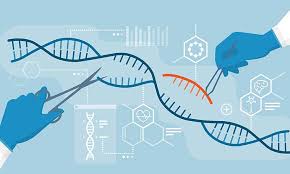Genome editing is revolutionizing genetics and molecular biology by allowing precise modifications to DNA sequences. This cutting-edge field has enormous implications for medicine, agriculture, and biotechnology. The development of advanced genome-editing technologies, such as Clustered Regularly Interspaced Short Palindromic Repeats (CRISPR), Transcription Activator-Like Effector Nucleases (TALENs), and Zinc Finger Nucleases (ZFNs), has enabled scientists to edit genes with remarkable accuracy and efficiency. This article explores the fundamental principles, mechanisms, advantages, applications, and future potential of these technologies.
The global genome editing market, valued at US$ 5.5 billion in 2022, is expected to experience significant growth, reaching over US$ 17.5 billion by 2031. With a CAGR of 13.9% from 2023 to 2031, this expansion is driven by increasing applications in gene therapy, agriculture, and biotechnology. The rising prevalence of genetic disorders, advancements in CRISPR and other editing technologies, and growing investments in research and development are key factors fueling market growth. As genome editing continues to evolve, it is poised to revolutionize healthcare and precision medicine in the coming years.
Genome editing technologies allow scientists to modify an organism’s DNA by inserting, deleting, or altering specific genes. These technologies rely on engineered nucleases, or “molecular scissors,” that create targeted breaks in the DNA sequence. The cell then repairs these breaks, often introducing specific changes.
The three primary genome-editing technologies are:
- CRISPR-Cas9 – The most widely used, efficient, and precise genome-editing tool.
- TALENs – A highly specific genome-editing technique with applications in gene therapy and research.
- ZFNs – One of the earliest genome-editing tools, though now largely replaced by CRISPR and TALENs.
Other emerging technologies, such as prime editing, base editing, and meganucleases, are also gaining attention in the field.
2. CRISPR-Cas9: The Game Changer
2.1 What is CRISPR-Cas9?
CRISPR-Cas9 is an advanced genome-editing tool adapted from a bacterial immune defense mechanism. Bacteria use CRISPR sequences to store fragments of viral DNA and produce RNA molecules that guide the Cas9 enzyme to specific genetic sequences for destruction. Scientists have harnessed this system for precise genome editing.
2.2 How CRISPR Works
CRISPR consists of two key components:
- Guide RNA (gRNA) – A custom-designed RNA sequence that directs Cas9 to a specific DNA sequence.
- Cas9 Enzyme – A DNA-cutting enzyme that creates double-strand breaks at the targeted site.
Once the DNA is cut, the cell’s repair mechanisms introduce mutations that either disrupt or correct the gene.
2.3 Advantages of CRISPR
- Highly specific and efficient
- Easier to design and implement compared to TALENs and ZFNs
- Cost-effective and widely accessible
- Versatile, working in various organisms and cell types
2.4 Applications of CRISPR
- Medicine: Gene therapy for genetic diseases like sickle cell anemia and cystic fibrosis.
- Agriculture: Development of disease-resistant and high-yield crops.
- Biotechnology: Creating genetically modified organisms (GMOs) for research and industry.
Despite its advantages, CRISPR has ethical concerns, including unintended mutations and potential misuse in human germline editing.
3. TALENs: Precision in Genome Editing
3.1 What are TALENs?
TALENs (Transcription Activator-Like Effector Nucleases) are artificial enzymes engineered to cut DNA at specific locations. They are derived from transcription activator-like effectors (TALEs) found in bacteria.
3.2 How TALENs Work
TALENs consist of two parts:
- DNA-binding domains – Recognize and bind to specific DNA sequences.
- FokI Nuclease – Cuts the DNA at the targeted site when two TALEN molecules bind to opposite DNA strands.
3.3 Advantages of TALENs
- High specificity and reduced off-target effects
- Effective in editing complex genomes
- Capable of modifying larger DNA sequences compared to CRISPR
3.4 Applications of TALENs
- Gene therapy: Used in experimental treatments for genetic disorders.
- Agriculture: Engineering crops with improved resistance to pests and diseases.
- Biomedical research: Creating disease models for drug testing.
TALENs require extensive protein engineering, making them more complex and expensive compared to CRISPR.
4. Zinc Finger Nucleases (ZFNs): The Pioneers
4.1 What are ZFNs?
ZFNs are engineered proteins that combine zinc finger DNA-binding domains with the FokI nuclease to create site-specific DNA breaks. They were the first genome-editing tools developed and paved the way for TALENs and CRISPR.
4.2 How ZFNs Work
ZFNs function similarly to TALENs but use zinc finger domains to recognize specific DNA sequences. The FokI nuclease then introduces double-strand breaks, prompting DNA repair.
4.3 Advantages of ZFNs
- Effective for gene therapy and research
- Can be used in various cell types and organisms
- Precise targeting capability
4.4 Applications of ZFNs
- Gene therapy: Used in clinical trials for diseases like HIV.
- Biomedical research: Editing model organisms for studying genetic disorders.
- Biotechnology: Genetic modifications in plants and animals.
ZFNs are technically challenging to design and have largely been replaced by CRISPR due to its simplicity and efficiency.
5. Emerging Genome-Editing Technologies
5.1 Base Editing
Base editing is a modified CRISPR technique that enables direct conversion of one DNA base into another without cutting the DNA. It is useful for correcting point mutations in genetic diseases.
5.2 Prime Editing
Prime editing is an advanced CRISPR-based method that allows precise DNA modifications without creating double-strand breaks, reducing the risk of unintended mutations.
5.3 Meganucleases
Meganucleases are highly specific genome-editing enzymes that cut long DNA sequences. However, they are difficult to engineer for new targets.
These emerging tools offer even greater precision, safety, and efficiency in genome editing.
6. Ethical and Regulatory Considerations
The ability to edit the human genome raises significant ethical and legal challenges. Key concerns include:
- Off-target effects and unintended mutations
- Potential misuse in human enhancement or designer babies
- Environmental impact of genetically modified organisms (GMOs)
- Regulatory oversight and safety of gene therapy treatments
Governments and scientific organizations worldwide are developing guidelines to ensure responsible use of genome-editing technologies.








Leave a Reply